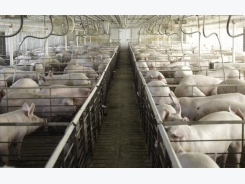EU: Stepwise tactics proposed to limit copper in piglet feed

© istock/Jetvic
A piecemeal approach to a reduction of copper content in feed for piglets was proposed at an EU Commission meeting earlier this month.
The levels of copper, an essential trace element for pigs, in feed for pigs was on the agenda at the Standing Committee on Plants, Animals, Food and Feed (SCOPAFF) meeting on 8-10 November.
The debate, within the SCOPAFF framework, was prompted by an opinion published by the European Food Safety Authority (EFSA) last year.
That Authority recommended lowering copper (Cu) for piglets, the species with the highest Cu supplementation allowance in the EU, to 25mg/kg of feed, as opposed to the current level of 170 mg/kg of feed, for environmental protection reasons.
A spokesperson for the Commission told us: “Many member states supported the idea - presented by the Commission - to not immediately reduce the Cu content in feed for piglets to the levels recommended by EFSA but rather to have a stepwise approach. Discussions will continue.”
Background to EFSA opinion
The Commission had asked EFSA to issue an opinion on the maximum content of compounds of Cu in feed that would fully meet the animals’ nutritional needs for Cu as a trace element and would be safe for the animals, the consumer and the environment.
The working group (WG) of the FEEDAP tasked with the mandate had to evaluate the relationship between levels of dietary Cu in animals and differences in their gastrointestinal microbiota to see if there was a need to amend the levels of Cu for use in feed.
In July 2016, Jürgen Gropp, chair of that WG, said extensive data collection, acquired through procurement, helped the experts in their assessment and allowed them to identify Cu levels that it believes are “necessary from a nutritional point of view”.
The group, he said, had to take into account the environmental impact of Cu residues in soil, particularly from piglet husbandry, while also ensuring there would no negative impact on animal welfare, safety and productivity from a reduction in Cu levels allowed in feed.
Industry alarmed
However, the UK’s National Pig Association (NPA), earlier this month, expressed concern that any dramatic reduction in copper limits, coming at the same time as the industry faces the loss of zinc oxide and pressure to reduce antibiotic use, would make it very difficult to control post-weaning diarrhea in piglets.
“We need to avoid drastic reductions so that members can focus on antibiotic reduction unhindered at this critical time," said NPA senior policy advisor, Georgina Crayford.
She said numerous studies have shown that supplementation of the diet with copper (Cu) at pharmacological levels (150–250 mg/kg) improves growth performance in weaned pigs. This is why commercial diets for weaned pigs up to 12 weeks generally contain a Cu supplement close to 170 mg/kg in the EU, stated Crayford in a recent letter to the UK’s Food Standards Agency, (FSA).
“It is believed that inclusion of copper at pharmacological levels supports the gut health of pigs."
She said the NPA recognized the importance of minimizing harm to soil ecosystems from elevated concentrations of heavy metals, including Cu. She cited research by the UK Centre for Ecology and Hydrology that identified a statistically significant increase in Cu concentrations in UK soils between 1998 and 2007, but in arable land where most animal manure is applied.
"This suggests that extraction of copper from the soil by cropping helps to prevent increases in concentrations of this metal from application of animal manure. It is for these reasons that NPA strongly opposes substantial reductions in permitted copper levels for piglet feed."
Growth response
EFSA's advice to minimize copper inclusions in piglet feed does not recognize the growth benefits of higher dosage levels, an expert told this publication.
Talking to us last year, Jan Fledderus, innovation manager piglets, Nutrition Innovation Center, ForFarmers Group, said the conclusion of a 2015 study by Bikker et al was that the addition of 25 mg Cu/kg is sufficient to avoid Cu related deficiency problems in piglets, but that there is a very strong positive linear response on growth and feed efficiency when Cu contents are increased up to 170 mg/kg.
“Any reduction of the copper content will increase the environmental pollution, since more feed will be needed to realize the same piglet performance. In addition, it is also likely [that there would be] an increase in mortality when the Cu content will be reduced to maximum of 25 mg/kg.
And the positive effect of Cu on growth performance and feed efficiency are not restricted to the weaner phase,” argued Fledderus.
Related news
Tools

Phối trộn thức ăn chăn nuôi

Pha dung dịch thủy canh

Định mức cho tôm ăn

Phối trộn phân bón NPK

Xác định tỷ lệ tôm sống

Chuyển đổi đơn vị phân bón

Xác định công suất sục khí

Chuyển đổi đơn vị tôm

Tính diện tích nhà kính

Tính thể tích ao



 Young pigs may see gut health boost from…
Young pigs may see gut health boost from…  Model shows pathogen survival in feed ingredients
Model shows pathogen survival in feed ingredients